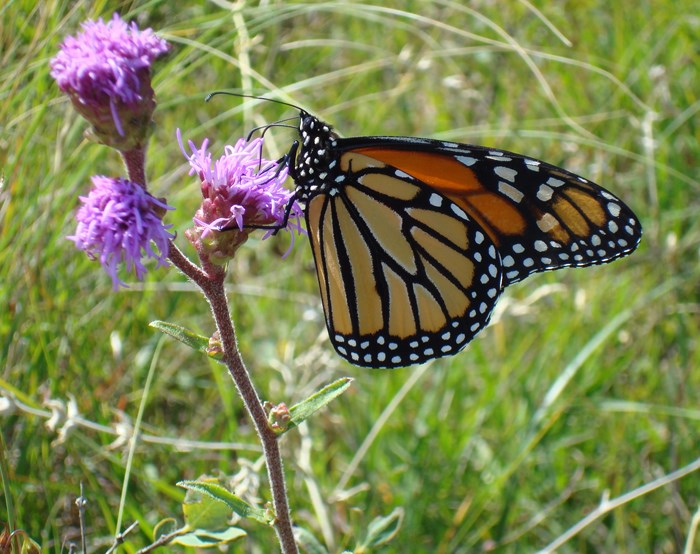Have you always wanted to see a Monarch butterfly? NOW is prime time! It takes 3 to 4 generations of butterflies to complete the migration they undertake, and the final generation starts here! Each generation lives only a few weeks, migrating north and laying eggs along the way, until Late August. The last generation lives for up to 9 months, starts as far north as here in Saskatchewan, migrates south, overwinters in Mexico or California, and finally lays eggs in the spring.
Monarch Butterflies complete the longest and largest insect migration in North America. “It’s hard to believe, but birds aren’t the only ones to travel thousands of kilometers due to the changing of the seasons,” says Ashley Fortney, Habitat Stewardship Coordinator with the Stewards of Saskatchewan programs. Millions of these butterflies, every year, somehow fly south up to 5,000 kilometers. “It’s somewhat mind boggling when you think of a Monarch being born halfway through migration, transforming from a caterpillar to a butterfly, and then simply knowing which direction to fly.”
Monarch butterflies are identifiable by their bright orange colouring, black veins through their wings, along with white spots on their black body and trailing the outside edges of the wings. A male Monarch has two distinct dots on its hindwing, which distinguishes it from a female. “Don’t be fooled – there are a few Monarch lookalikes, the most notorious of which is the Viceroy,” Fortney mentions. The colouring and patterns are very similar to the Monarch, but a Viceroy has an extra stripe on its hindwings which intersects the other veins.
In Saskatchewan, the Monarch is distributed across the southern portion of the province, and is seen throughout mid to late summer as they finish the northern extent of their migration. Of the two populations of Monarchs in North America, the Eastern population is the one sighted in Saskatchewan, with the Rocky Mountains as a barrier to the Western population.
Monarch numbers have dropped by as much as 90% across North America. The three lowest overwintering populations in Mexico on record occurred in the last 10 years. One of the largest threats to these butterflies is habitat loss, both in the winter and summer breeding grounds, due to logging, destructive bark beetles, agriculture, urban development, and pesticide use affecting milkweed and wildflowers.
Monarchs rely on Milkweed plants for survival. The butterflies lay their eggs on the undersides of the leaves, and larvae feast on the leaves growing 2,000 times their size! Bitter heart toxins from the plant are stored within the Monarch making them unpalatable to predators. “This is why there are Monarch lookalikes out there,” explains Fortney, “they pretend to be the poisonous Monarch to trick other animals into thinking they’re not a good meal.”
To help these butterflies, you can plant Milkweed, “even in your own backyard,” Fortney says, “it is very important that this plant is available to the Monarchs.” Another thing you can do to help Monarch research and conservation is to report a sighting of the butterfly. “Every sighting helps to determine the numbers and the range of the Monarch population,” Fortney concludes. If you see a Monarch butterfly in Saskatchewan, or for more information, call Nature Saskatchewan’s toll-free line at 1-800-667-HOOT (4668).




